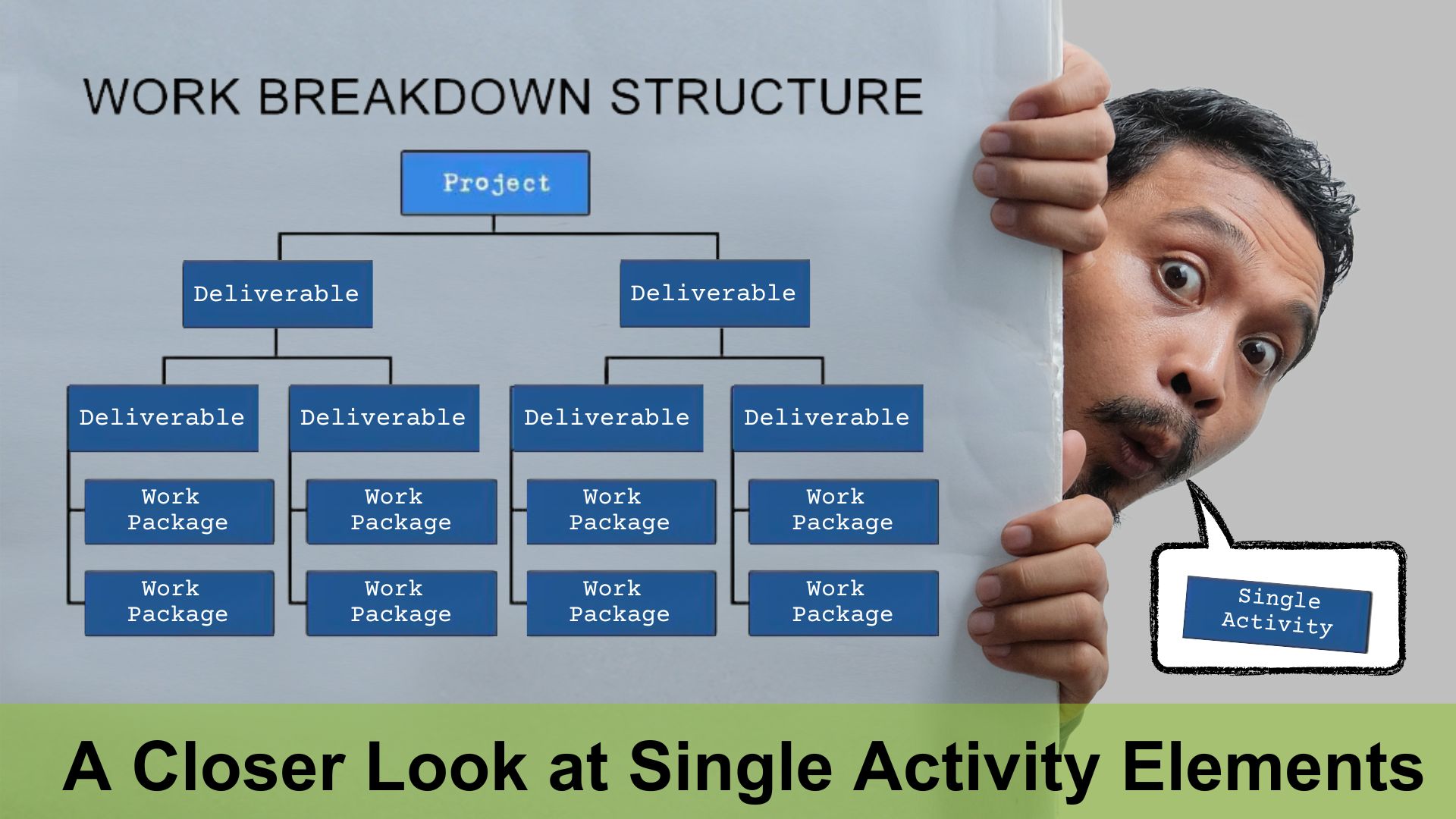
In this article:
- Understanding over-decomposition
- Risks of under-decomposition
- Inadequate resource management
- Striking the right balance
- Circumstances when a WBS element with a single activity is acceptable
- Summary
The Importance of Balanced Decomposition in Work Breakdown Structures: A Closer Look at Single Activity Elements
A Work Breakdown Structure (WBS) is a crucial project management tool that organizes the total scope of work into manageable sections, ensuring clear definition, assignment, and tracking of tasks. However, the issue of having a WBS element with a single activity poses significant challenges, often resulting from either over-decomposition or under-decomposition. This article explores these challenges and provides insights from leading project management standards and experts.
Understanding Over-Decomposition
Having a WBS element with a single activity may signify the occurrence of over-decomposition, which is when a WBS is broken down into excessively detailed components. In laymen’s terms: it went too far. While the intention might be to achieve precise control and granularity (fine level of detail), this practice can lead to several complications:
Increased Complexity:
When WBS elements are broken down excessively, it results in an overly complex WBS that is difficult to manage and maintain.
- PMBOK® Guide: Emphasizes that decomposition should provide a clear and manageable breakdown of project work. Overly detailed elements add unnecessary complexity, making it difficult to manage and understand the project scope effectively (PMI).
- Harold Kerzner: Highlights that the WBS should balance detail with manageability. Over-decomposition can complicate project management without adding significant value, leading to inefficiencies in resource allocation and tracking (Internet Archive).
- AACE advises against excessive decomposition as it can complicate project management unnecessarily. (Recommended Practice 113R-10)
Administrative Overhead:
An over-decomposed WBS can lead to administrative burden due to the complexity of the breakdown.
- Gregory T. Haugan: Stresses that a well-constructed WBS should facilitate project planning and control. Single-activity elements can increase administrative burden, as more effort is required to locate, track and manage each element and activity (Perlego) (O'Reilly Media).
Micromanagement and Loss of Strategic Focus:
Having too many small activities can lead to micromanagement, where project managers might focus on trivial details instead of strategic objectives. This can stifle team autonomy and reduce overall productivity and morale.
Duplication of Effort:
Creating a WBS level for a single activity can also be a duplicative effort, which is a poor use of your planning resource.
- Hans du Toit from Profactaplan notes that, "that single activity already possesses everything necessary for control. The manpower of that activity, its costs, its responsibility, etc. is already defined, hence creating a WBS element for that single activity will result essentially in duplication of the activity at WBS level, thus serving no purpose."
Risks of Under-Decomposition
A WBS element with a single activity may suggest under-decomposition of the WBS, where WBS elements are not broken down sufficiently. In this instance, it hasn’t gone far, or deep enough, and may need further decomposition. As with over-decomposition, under-decomposition presents significant risks:
Lack of Detail:
Each WBS element should be detailed enough to ensure that the scope is clear and manageable. Having single-activity elements may result in lack of clarity in scope which, in turn, can lead to scope creep as the boundaries of the activity may not be well defined.
PMBOK® Guide: Underlines the necessity of adequate decomposition to provide a comprehensive understanding of the project's scope. Insufficient detail can lead to overlooking critical tasks and dependencies, resulting in incomplete project planning (PMI).
AACE: emphasises the need for a comprehensive breakdown to ensure all work is captured effectively (Total Cost Management (TCM))
Inadequate Resource Management:
Without detailed breakdown, it becomes challenging to allocate resources effectively. This can lead to resource conflicts and inefficiencies as the project progresses.
AACE indicates that breaking WBS elements down sufficiently to capture all necessary activities, helps in better estimating, scheduling and monitoring. (Recommended Practice 113R-10)
Difficulty in Monitoring and Control:
With single-activity elements, the lack of detail might make it challenging to track progress, performance and costs effectively.
Gregory T. Haugan: Points out that a well-structured WBS should support effective monitoring and control. Under-decomposed elements do not provide the granularity (fine detail) needed for detailed tracking, making it harder to identify issues early and manage project performance (O'Reilly Media).
Striking the Right Balance
Achieving the right level of decomposition is crucial for effective project management. The following guidelines can help ensure balanced decomposition:
1. Focus on Deliverables:
Both PMBOK and AACE emphasize the importance of focusing on deliverables. Each WBS element should represent a meaningful component of the project's scope that contributes to the overall deliverable, rather than breaking down into trivial activities.
2. Establish Clear Criteria for Decomposition:
Define criteria for when to stop decomposing WBS elements. The goal is to reach a level where work packages are manageable, measurable, and controllable, providing sufficient detail for planning and execution without becoming overly complex.
3. Iterative Review and Adjustment:
Review each WBS element to ensure that it is necessary and contributes to clear project scope and effective control. Avoid breaking down tasks beyond the level where it adds value to project management, or stopping before it could do so.
Circumstances When a WBS Element with a Single Activity is Acceptable
Standard recommendation is to avoid single-activity WBS elements due to the challenges outlined however, there are certain circumstances where it might be deemed acceptable:
1. Unique or Specialized Tasks:
When the task is unique or highly specialized and cannot be broken down further without losing clarity or meaning. For instance, in cases where a single contractor or specialist is responsible for the activity and it is not feasible to decompose the task further.
2. External Constraints:
When external constraints, such as contractual obligations or regulatory requirements, dictate that a particular task must be managed as a single activity.
3. High-Level Reporting:
In scenarios where high-level reporting is required, and the details of individual activities are managed separately in a detailed schedule or other planning documents.
4. Mature Project Phases:
During mature phases of a project where detailed decomposition has already been performed earlier, and only high-level summaries are needed for final tracking and reporting.
Sean Vermaak from Profactaplan says: “There are circumstances when you will find this in a schedule, but it needs to be viewed to ensure it is in fact the only way to group that single activity. So, there are exceptions to this practice, but it needs to be checked for legitimacy” By recognizing these specific situations, project planners can make informed decisions about when it is appropriate to have a single-activity WBS element without compromising the overall effectiveness of the project management process. Since no hard rules exist to govern this element, experience and common sense must provide the parameters for examining the legitimacy of single activity elements, Sean explains “One needs to ask: “Is it the most suitable place for it to be house (under WBS)?”
Conclusion
The creation of a WBS is a fundamental aspect of project management that requires a delicate balance between too much and too little detail. Over-decomposition can lead to unnecessary complexity and administrative burden, while under-decomposition can result in insufficient detail and inadequate project control. Having single-activity elements may sometimes suffice, but often it is better to have multiple activities to ensure clarity in scope, schedule and cost tracking.
By adhering to industry standards and expert recommendations, project planners can develop a WBS that effectively supports project planning, execution, and control, ensuring the successful delivery of project objectives.
For further reading, refer to the PMBOK® Guide by PMI, Effective Work Breakdown Structures by Gregory T. Haugan, and Project Management: A Systems Approach to Planning, Scheduling, and Controlling by Harold Kerzner. If you have AACE membership, also refer to AACE International. (2015). Total Cost Management Framework, AACE International. (2011). Skills and Knowledge of Cost Engineering, AACE International. (2017). Recommended Practice 113R-10: Project Code of Accounts, AACE International. (2012). Recommended Practice 114R-11: Project Controls—Considerations for Simple, Linear, and Modular Projects. As a non-member you may consider buying individual AACE resources.
These resources provide comprehensive insights into the principles and practices of creating effective WBS.
